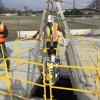Financial News
Sewer Tunnel Designed by WSP USA Will Be Longest Built in St. Louis
Seven-mile tunnel will improve water quality in Meramec River watershed, consolidate Metropolitan St. Louis Sewer District wastewater treatment plant operations.
SOURCE: WSP
DESCRIPTION:
Construction has begun on the longest sewer tunnel project ever attempted in the St. Louis region – a project designed by WSP USA.
When complete in 2024, the 6.8-mile-long Lower Meramec Tunnel will enhance the region’s sewer network and improve water quality within the Meramec River watershed on the south side of the metropolitan St. Louis area.
Located in south St. Louis County, the $174 million tunnel will traverse a region that also includes the cities of Sunset Hills and Fenton. The depth of cover ranges from 78 to 286 feet, largely controlled by surface topography. The excavated tunnel diameter is planned to be 14.5 feet with an 8-foot internal diameter final lining.
“The main objective of the tunnel is to intercept flows and to take offline the interim Fenton Wastewater Treatment Facility,” said Everett Litton, project manager for WSP. “The tunnel will be constructed entirely in rock and is anticipated to operate under both open channel and submerged hydraulic flow conditions.”
WSP provided preliminary and final design services for the Metropolitan St. Louis Sewer District (MSD) and will continue to provide engineering services throughout construction. WSP is working with HDR, the prime consultant for this project.
WSP is the lead tunnel design firm with responsibilities related to design of the deep tunnel, specifications for the tunnel boring machine, drop structure design, geotechnical engineering and design, risk identification and preparation of the geotechnical baseline report.
Design work was completed in 2020, and construction began in January 2021.
MSD serves approximately 1.3 million residents and is the fourth largest wastewater collection system in the U.S.
Comprehensive Initiative
In 2011, MSD began implementation of Project Clear, a complex 23-year, $4.5 billion capital improvement program for its sewer system to protect public health and safety while ensuring compliance with regulatory issues and requirements, which includes the Lower Meramec Tunnel project. It is part of the MSD consent decree program, an agreement established with the U.S. Environmental Protection Agency.
During previous Baumgartner Tunnel construction, which connects to the Lower Meramec Tunnel, significant groundwater inflows were previously encountered. As part of the design process for the Lower Meramec Tunnel, WSP conducted a comprehensive and phased geotechnical investigation program to mitigate project risks, along with extensive packer permeability testing in every deep borehole and performed aquifer testing at key project locations.
To quantify the amount of anticipated groundwater expected within the excavated tunnel and shafts, data from 493 packer tests were utilized to baseline an adequate inflow for bidding purposes.
“Based upon prior tunnel construction, the geologic conditions within the project area are prone to significant groundwater inflows,” Litton said. “The Lower Meramec Tunnel project will ultimately help eliminate the discharge of the interim wastewater treatment facility as part of the Missouri Department of Natural Resources’ long-term plan for the region. The project will help consolidate and simplify MSD’s wastewater treatment plant operations.”
The new tunnel will connect to the existing Baumgartner Tunnel and includes construction of the Fenton construction shaft; installation of the final lining at the Baumgartner construction shaft; construction of six drop structures, including near-surface structures, drop shafts, vent shafts, deaeration chambers and tunnel adits (mine entrance); installation of a bulkhead at the Fenton construction shaft; demolition of existing pump stations; and near-surface sewer connections to drop structures.
“The six drop structures are included within the design to accommodate as much gravity flow to the tunnel as is practical and economical,” Litton said. “Four types of drop structures were considered: tangential vortex, vortex with helical ramps, plunge inlet and baffle type drop structures. Both plunge and tangential vortex drop structures were considered suitable and utilized for the project.”
Environmental Benefits
Several noteworthy design elements were incorporated into the Lower Meramec Tunnel project to accommodate environmental requirements for the project.
A previously abandoned wastewater lagoon located near the tunneling site was re-purposed for the storage of approximately 352,000 cubic yards of excavated rock, known as tunnel muck.
“This re-purposed lagoon eliminates 29,300 dump truck trips, saving local roadways from the wear and tear of these trips,” Litton said. “Together with reductions in fuel consumption and truck handling, this will provide significant reductions to the project’s carbon footprint.”
Additionally, fiberglass reinforced pipe was specified to accommodate a planned 100-year life cycle for the tunnel, which is inherently longer lasting and more sustainable as compared to other alternatives considered.
The project is using funds from Missouri’s Clean Water State Revolving Fund (SRF), a loan program that provides low-interest financing to construct wastewater and stormwater projects that improve water quality. At the time of bidding, the Lower Meramec Tunnel was the largest SRF project in Missouri history.
To reach this point required significant collaboration between all stakeholders in the project throughout the design, as well as coordination with several utilities, agencies and municipalities. Throughout the design phase, public meetings were held to discuss homeowner concerns along the project corridor.
Litton has appreciated the opportunity to work on a project that will have a major impact on the health and safety of his community.
“I enjoy contributing to projects with grand ambition and those that provide tangible benefits to the environment and community,” Litton said. “I’ve personally skied, fished and kayaked the Meramec River and am grateful to be involved in Project Clear. I am incredibly proud to be involved in such a wonderful project with an amazing team that will ultimately help to improve the rivers and streams in my hometown.”
[To subscribe to Insights, contact the editorial staff at insights@wsp.com.]
KEYWORDS: TSX:WSP, WSP, St. Louis, Sewer Tunnel
![]()


More News
View More





Quotes delayed at least 20 minutes.
By accessing this page, you agree to the following
Privacy Policy and Terms Of Service.



